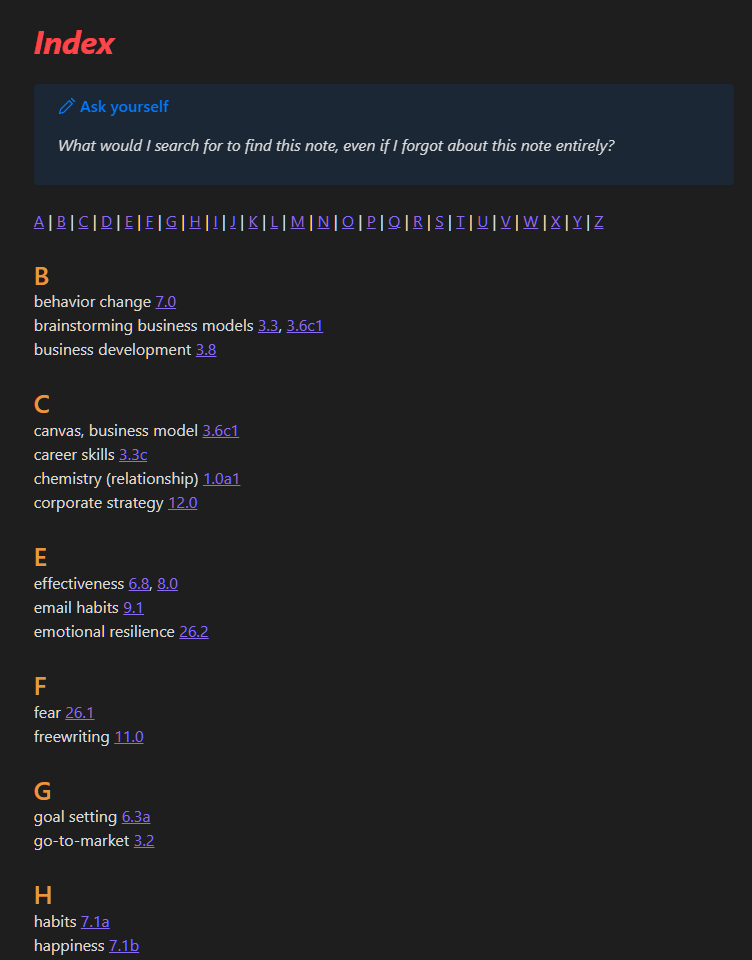How "closely" must a slip be linked to the index?
In "How to Take Smart Notes", Ahrens states that before you add a slip to your slipbox, you should:
"Make sure it can be found from the index; add an entry in the index if necessary or refer to it from a note that is connected to the index." (p. 104)
Originally, I thought it was just important that no slip gets orphaned and is connected to some thread of notes, but this statement gives me the impression that every slip must be no more than 1 degree of separation away from the Index. But once your slipbox grows a significant amount, this will cause your index to get cluttered, which runs counter to what he says later:
"[Keywords in the index] should be chosen carefully and sparsely. Luhmann would add the number of one or two (rarely more) notes next to a keyword in the index." (p. 106)
How do you interpret this for Zettelkasten? Is it crucial that there's no more than 1 degree of separation from your index? Or is it just important that it's eventually connected (e.g. with potentially 2, 5, 10, or more notes between the Index and the new slip)?
Howdy, Stranger!
Comments
Philosophy
It depends on what you mean by "index." A structure note is an annotated index. With that as the definition, all notes, with a few minor exceptions, should be on a structure note. The difference is that there can be several indexes/structure notes, especially when a ZK grows to 3K+ notes. Having them all linked to a single index is impracticable. This is how one starts, placing all the links on a single index. Different categories become evident as the ZK grows and can be corraled onto their own index. In this way, a ZK grows organically without an advanced imposed structure. It is freer to express itself and follows your true interests.
Practical
Even some structure notes have gotten too large to manage and have fostered off-shoots, which I call sub-hub. Each sub-hub has a prominent position on the hub that birthed it. I place a prompt on all my templates to remind me to hang a new note on a hub or sub-hub before releasing it out of the inbox.
Hubs or structured indexes (19)
Sub-hubs or structured indexes (49)
Will Simpson
My peak cognition is behind me. One day soon, I will read my last book, write my last note, eat my last meal, and kiss my sweetie for the last time.
My Internet Home — My Now Page
@Mach3Maelstrom I take a different approach than @Will . I do use structure notes, but not to the same extent. Rather, I make sure all zettels have proper tags and that no tag is used on more than about 5 (maximum 10) zettels. Sometimes that requires "splitting" tags so that they are more specific. My list of tags then becomes my de facto index.
I link the index from the note, so the "what links here" pane for each index shows all the notes that link to it.
GitHub. Erdős #2. Problems worthy of attack / prove their worth by hitting back. -- Piet Hein. Alter ego: Erel Dogg (not the first). CC BY-SA 4.0.
@Will - Thanks for sharing your hub notes; looks like a solid engineering/Stoicism mindset to me.
When I refer to "index", I'm referring to a page of entry points into the Zettelkasten according to where I'd like to "plug into the Matrix". These entry points are often what you refer to as Hub notes, but if a subject is relatively young (e.g. 2-3 notes), I tend to tag the one that linked the others until I feel a Hub is required.
Here's a screenshot of my index as it stands now.

@GeoEng51 - I began testing your tagging method when you shared it with me earlier, but found that I simply grew fond of the Index function. I tweaked your #unlinked tag method by creating #zk-explore, which I use to denote specifically what types of zettels I want to create (or links I want to find) to connect with this slip.
@ZettelDistraction - Interesting idea! Then I take it instead of keywords, you skim your main index backlink list for interesting Zettels to do your dives into your slipbox?
Overall, what I'm seeing is that it's not so important that a slip be 1 degree of separation from a "main index". As long as it's connected to a relevant chain, it's OK.
In Obsidian, you can create small scripts within notes, so I added this DataviewJS script to my Zettel Template to confirm that the slip I'm creating can be reached from my Index (e.g. Index --> Number of Slips --> Slip I'm Creating)
let page = dv.current().file.path; let pages = new Set(); let stack = [page]; while (stack.length > 0) { let elem = stack.pop(); let meta = dv.page(elem); if (!meta) continue; for (let inlink of meta.file.inlinks.array()) { console.log(inlink); if (pages.has(inlink.path)) continue; pages.add(inlink.path); stack.push(inlink.path); } } // Data is now the file metadata for every page that directly OR indirectly links to the current page. let data = dv.array(Array.from(pages)).map(p => dv.page(p)).filter(p => p.file.name == "_Index"); if(data.length == 0){ dv.paragraph("INDEX CHECK: NOT linked to Index!!!!!") } else { dv.paragraph("INDEX CHECK: Linked to Index") }Edit @ctietze 2025-09-29: Fixed formatting
I just link where it makes sense to me—if a note seems important across topics, I’ll add it to the index, but tons just live through links from other notes.